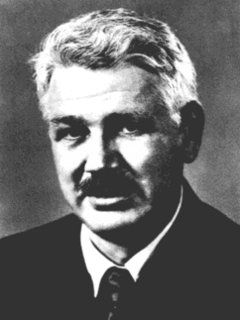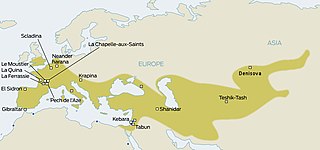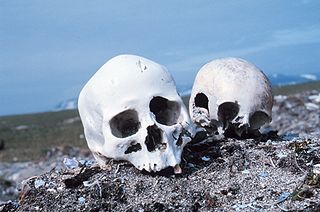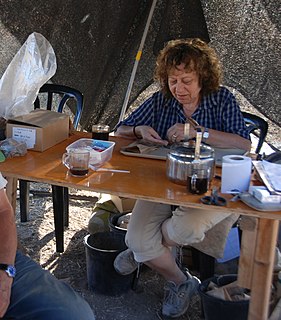Related Research Articles

The Paleolithic or Palaeolithic or Palæolithic, also called the Old Stone Age, is a period in human prehistory distinguished by the original development of stone tools that covers c. 99% of the period of human technological prehistory. It extends from the earliest known use of stone tools by hominins c. 3.3 million years ago, to the end of the Pleistocene c. 11,650 cal BP.

Carleton Stevens Coon was an American anthropologist. A Professor of Anthropology at the University of Pennsylvania, lecturer and professor at Harvard University, he was president of the American Association of Physical Anthropologists. Coon's theories on race were widely disputed in his lifetime and are considered pseudoscientific in modern anthropology.

The Mousterian is a techno-complex of stone tools, associated primarily with the Neanderthals in Europe, and to a lesser extent the earliest anatomically modern humans in North Africa and West Asia. The Mousterian largely defines the latter part of the Middle Paleolithic, the middle of the West Eurasian Old Stone Age. It lasted roughly from 160,000 to 40,000 BP. If its predecessor, known as Levallois or Levallois-Mousterian, is included, the range is extended to as early as c. 300,000–200,000 BP. The main following period is the Aurignacian of Homo sapiens.
The Middle Paleolithic is the second subdivision of the Paleolithic or Old Stone Age as it is understood in Europe, Africa and Asia. The term Middle Stone Age is used as an equivalent or a synonym for the Middle Paleolithic in African archeology. The Middle Paleolithic broadly spanned from 300,000 to 30,000 years ago. There are considerable dating differences between regions. The Middle Paleolithic was succeeded by the Upper Paleolithic subdivision which first began between 50,000 and 40,000 years ago. Pettit and White date the Early Middle Paleolithic in Great Britain to about 325,000 to 180,000 years ago, and the Late Middle Paleolithic as about 60,000 to 35,000 years ago.

Franchthi Cave or Frankhthi Cave is an archaeological site overlooking Kiladha Bay, in the Argolic Gulf, opposite the village of Kiladha in southeastern Argolis, Greece.

Jane Ellen Buikstra is an American anthropologist and bioarchaeologist. Her 1977 article on the biological dimensions of archaeology coined and defined the field of bioarchaeology in the US as the application of biological anthropological methods to the study of archaeological problems. Throughout her career, she has authored over 20 books and 150 articles. Buikstra's current research focuses on an analysis of the Phaleron cemetery near Athens, Greece.
Margaret W. Conkey is an American archaeologist and academic, who specializes in the Magdalenian period of the Upper Paleolithic in the French Pyrénées. Her research focuses on cave art produced during this period. Conkey is noted as one of the first archaeologists to explore the issues of gender and feminist perspectives in archaeology and in past human societies, using feminist theory to reinterpret images and objects from the Paleolithic Era or the late Ice Age. She is Professor Emerita of Anthropology at the University of California, Berkeley. She was named by Discover magazine in their 2002 article, "The 50 Most Important Women in Science".
Symbolic culture, or nonmaterial culture, is the ability to learn and transmit behavioral traditions from one generation to the next by the invention of things that exist entirely in the symbolic realm. Symbolic culture is usually conceived as the cultural realm constructed and inhabited uniquely by Homo sapiens and is differentiated from ordinary culture, which many other animals possess. Symbolic culture is studied by archaeologists, social anthropologists and sociologists. From 2018, however, some evidence of a Neanderthal origin of symbolic culture emerged. Symbolic culture contrasts with material culture, which involves physical entities of cultural value and includes the usage, consumption, creation, and trade of objects.
The year 2007 in archaeology
Harold Lewis Dibble was an American Paleolithic archaeologist. His main research concerned the lithic reduction, during which he conducted fieldwork in France, Egypt, and Morocco. He was a professor of Anthropology at the University of Pennsylvania and Curator-in-Charge of the European Section of the University of Pennsylvania Museum of Archaeology and Anthropology.

Paleolithic religions are a set of spiritual beliefs thought to have appeared during the Paleolithic time period. Paleoanthropologists Andre Leroi-Gourhan and Annette Michelson believe religious behaviour emerged by the Upper Paleolithic, before 30,000 years ago at the latest, but behavioral patterns such as burial rites that one might characterize as religious — or as ancestral to religious behaviour — reach back into the Middle Paleolithic, as early as 300,000 years ago, coinciding with the first appearance of Homo neanderthalensis and possibly Homo naledi.

Ksar Akil is an archeological site 10 km (6.2 mi) northeast of Beirut in Lebanon. It is located about 800 m (2,600 ft) west of Antelias spring on the north bank of the northern tributary of the Wadi Antelias. It is a large rock shelter below a steep limestone cliff.

Qesem cave is a Lower Paleolithic archeological site near the city of Kafr Qasim in Israel. Early humans were occupying the site by 400,000 until c. 200,000 years ago.
John W. Olsen, Ph.D., is an American archaeologist and paleoanthropologist specializing in the early Stone Age prehistory and Pleistocene paleoecology of eastern Eurasia. Olsen is Regents' Professor Emeritus of Anthropology and Executive Director of the Je Tsongkhapa Endowment for Central and Inner Asian Archaeology at the University of Arizona in Tucson, Arizona, USA. He is also a Leading Scientific Researcher at the Institute of Archaeology and Ethnography of the Russian Academy of Sciences' Siberian Branch in Novosibirsk and Guest Research Fellow at the Chinese Academy of Sciences' Institute of Vertebrate Paleontology and Paleoanthropology in Beijing where he is Co-Director of the Zhoukoudian International Paleoanthropological Research Center (周口店国际古人类研究中心联席主任). Olsen is also a Foreign Expert affiliated with The Yak Museum in Lhasa, Tibet (西藏牦牛博物馆国外专家).
Avi Gopher is an Israeli archaeologist. He is a professor at the University of Tel Aviv.

Yarimburgaz Cave is a cave of significant archaeological and paleontological importance, located within Istanbul Province, Turkey.

The Levantine Aurignacian is an Upper Paleolithic culture of the Near-Eastern Levant that evolved from the Emiran culture. It was named so because of the similarity of stone tools with the Aurignacian culture in Europe. The Levantine Aurignacian used to be called Lower and Upper Antelian in old sources, from the site of Wadi Antelias in Lebanon. The most important innovation in this period is the incorporation of some typical elements of Aurignacian, like some types of burins and narrow blade points that resemble the European type of Font-Yves.

Cueva de Bolomor, or Bolomor Cave, is an archaeological site near Tavernes de la Valldigna in the Valencian Community, Spain. It was occupied over a long period of time, between 350,000 and 120,000 years ago.

Anna Belfer-Cohen is an Israeli archaeologist and paleoanthropologist and Professor Emeritus at the Institute of Archaeology, The Hebrew University of Jerusalem. Belfer-Cohen excavated and studied many important prehistoric sites in Israel including Hayonim and Kebara Caves and open-air sites such as Nahal Ein Gev I and Nahal Neqarot. She has also worked for many years in the Republic of Georgia, where she made important contributions to the study of the Paleolithic sequence of the Caucasus following her work at the cave sites of Dzoudzuana, Kotias and Satsrublia. She is a specialist in biological Anthropology, prehistoric art, lithic technology, the Upper Paleolithic and modern humans, the Natufian-Neolithic interface and the transition to village life.
References
- 1 2 3 "About Mary C. Stiner". School of Anthropology, College of Social & Behavioral Science. University f Arizona. Retrieved 3 May 2020.CS1 maint: discouraged parameter (link)
- ↑ Bridget Alex (11 April 2020). "When Did Ancient Humans Begin to Understand Death?". Discover .
- 1 2 3 "Mary C Stiner". UA Profiles. Retrieved 3 May 2020.CS1 maint: discouraged parameter (link)
This article needs additional or more specific categories .(May 2020) |